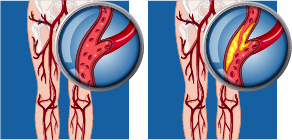How frequently is PAD asymptomatic? A study from admissions to a general hospital.
Published by Christian Trygstad on
A common question asked about PAD is, what percentage of people that have PAD are asymptomatic, or not displaying some of the classic symptoms of PAD, such as pain when walking (intermittent claudication)?
One study indicates that the percentage of those with PAD who are asymptomatic could be quite high.
The study consisted of 990 patients, with a mean age of 65 years. The study population was 52% women, 48% men, and were patients who had been treated at a general-care hospital for various diseases.
Based on case histories, those with symptomatic PAD consisted of 6% of the study population. Of the remaining 931 patients, all were assessed for PAD, and found that 44% of those without symptomatic PAD, had PAD without reported symptoms (asymptomatic PAD).
What is widely known about peripheral artery disease (PAD), is that patient outcomes are improved through early detection and intervention, but frequently, PAD is asymptomatic at the beginning of the progression of this chronic condition.
Results from this study further confirms that screening at-risk patient populations for PAD can uncover many cases of asymptomatic PAD, enabling the early management of the disease.


